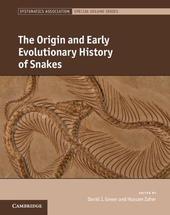
|
The Origin and Early Evolutionary History of Snakes
Hardback
Main Details
Description
Snakes comprise nearly 4,000 extant species found on all major continents except Antarctica. Morphologically and ecologically diverse, they include burrowing, arboreal, and marine forms, feeding on prey ranging from insects to large mammals. Snakes are strikingly different from their closest lizard relatives, and their origins and early diversification have long challenged and enthused evolutionary biologists. The origin and early evolution of snakes is a broad, interdisciplinary topic for which experts in palaeontology, ecology, physiology, embryology, phylogenetics, and molecular biology have made important contributions. The last 25 years has seen a surge of interest, resulting partly from new fossil material, but also from new techniques in molecular and systematic biology. This volume summarises and discusses the state of our knowledge, approaches, data, and ongoing debates. It provides reviews, syntheses, new data and perspectives on a wide range of topics relevant to students and researchers in evolutionary biology, neontology, and palaeontology.
Author Biography
David J. Gower is a Merit Researcher in Herpetology and Head of the Vertebrates Division in the Department of Life Sciences at The Natural History Museum, London. A collections-based, organismal biologist with interests in a wide range of topics in natural history and evolutionary biology, he has taxon expertise in Triassic archosaurs and limbless, mostly fossorial, amphibians and reptiles. Hussam Zaher is Full Professor and Curator of Herpetology and Vertebrate Paleontology in the Museum of Zoology at the University of Sao Paulo. He is an evolutionary biologist focusing on the systematics, palaeontology, and comparative anatomy of reptiles, with an emphasis on the diversity and evolutionary history of snakes and other squamates.
|